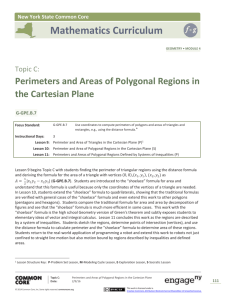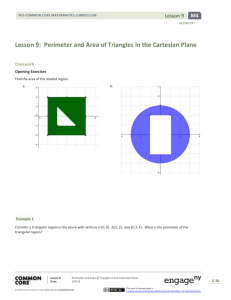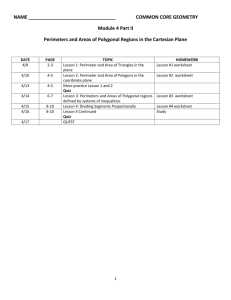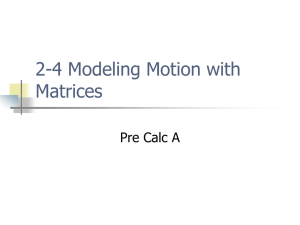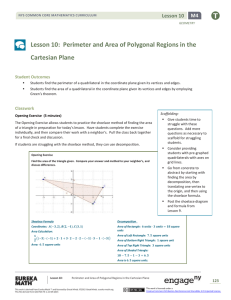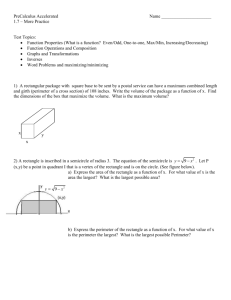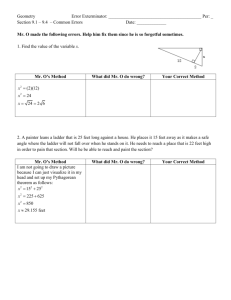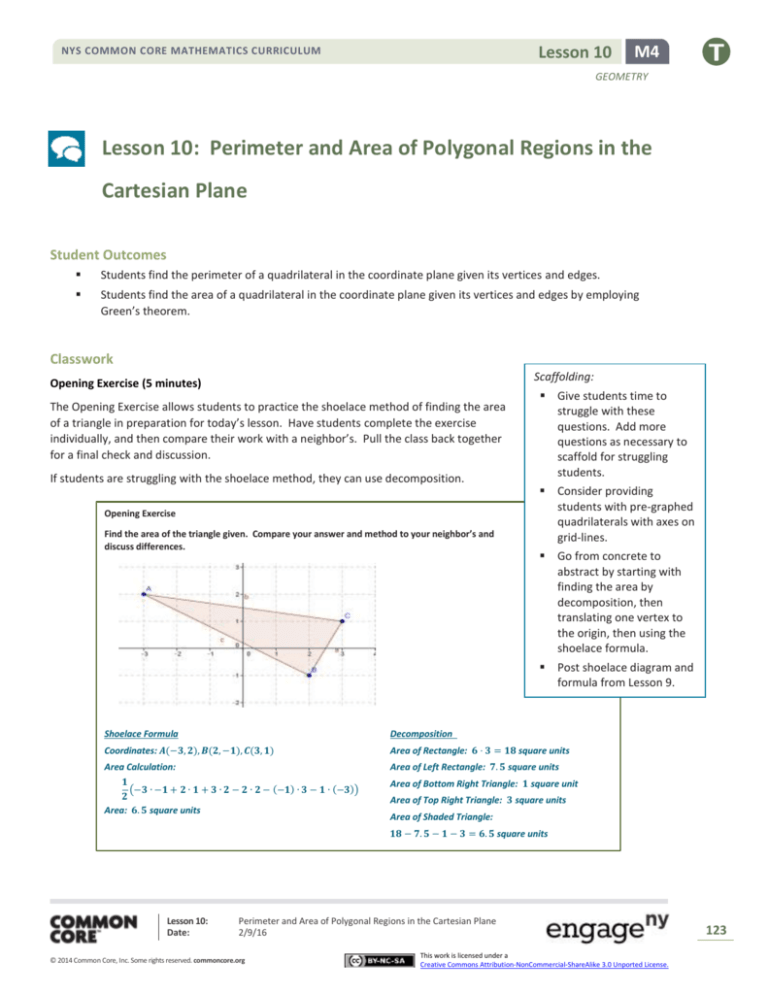
Lesson 10
NYS COMMON CORE MATHEMATICS CURRICULUM
M4
GEOMETRY
Lesson 10: Perimeter and Area of Polygonal Regions in the
Cartesian Plane
Student Outcomes
Students find the perimeter of a quadrilateral in the coordinate plane given its vertices and edges.
Students find the area of a quadrilateral in the coordinate plane given its vertices and edges by employing
Green’s theorem.
Classwork
Scaffolding:
Opening Exercise (5 minutes)
The Opening Exercise allows students to practice the shoelace method of finding the area
of a triangle in preparation for today’s lesson. Have students complete the exercise
individually, and then compare their work with a neighbor’s. Pull the class back together
for a final check and discussion.
If students are struggling with the shoelace method, they can use decomposition.
Opening Exercise
Find the area of the triangle given. Compare your answer and method to your neighbor’s and
discuss differences.
Give students time to
struggle with these
questions. Add more
questions as necessary to
scaffold for struggling
students.
Consider providing
students with pre-graphed
quadrilaterals with axes on
grid-lines.
Go from concrete to
abstract by starting with
finding the area by
decomposition, then
translating one vertex to
the origin, then using the
shoelace formula.
Post shoelace diagram and
formula from Lesson 9.
Shoelace Formula
Decomposition
Coordinates: 𝑨(−𝟑, 𝟐), 𝑩(𝟐, −𝟏), 𝑪(𝟑, 𝟏)
Area of Rectangle: 𝟔 ⋅ 𝟑 = 𝟏𝟖 square units
Area Calculation:
Area of Left Rectangle: 𝟕. 𝟓 square units
𝟏
(−𝟑 ∙ −𝟏 + 𝟐 ∙ 𝟏 + 𝟑 ∙ 𝟐 − 𝟐 ∙ 𝟐 − (−𝟏) ∙ 𝟑 − 𝟏 ∙ (−𝟑))
𝟐
Area: 𝟔. 𝟓 square units
Area of Bottom Right Triangle: 𝟏 square unit
Area of Top Right Triangle: 𝟑 square units
Area of Shaded Triangle:
𝟏𝟖 − 𝟕. 𝟓 − 𝟏 − 𝟑 = 𝟔. 𝟓 square units
Lesson 10:
Date:
Perimeter and Area of Polygonal Regions in the Cartesian Plane
2/9/16
© 2014 Common Core, Inc. Some rights reserved. commoncore.org
This work is licensed under a
Creative Commons Attribution-NonCommercial-ShareAlike 3.0 Unported License.
123
Lesson 10
NYS COMMON CORE MATHEMATICS CURRICULUM
M4
GEOMETRY
Discussion (15 minutes)
In this lesson, students extend the area formulas for triangles studied in Lesson 9 to quadrilaterals and discover that the
formula works for any polygonal region in the coordinate plane. Remind students that they should pick a starting point,
and then initially move in a counterclockwise direction as they did in Lesson 9.
Recall the question that we ended with last lesson:
Does the shoelace area formula extend to help us find
the areas of quadrilaterals in the plane? Look at the
quadrilateral given—any thoughts?
Allow students time to come up with ideas, but try to lead them
eventually to decomposing the quadrilateral into triangles so
MP.7 you can use the formula from Lesson 9. Have students each try
the method they suggest initially and compare and contrast
methods.
Answers will vary. Students may suggest
enclosing the quadrilateral in a rectangle and
subtracting triangles as we did in the
beginning of Lesson 9. They may suggest
measuring and calculating from traditional
area formulas. Try to lead them to suggest
that we can divide the quadrilateral into two
triangles and use the formula from the last lesson
to find each area, and then add the two areas.
Let’s try it and see if it works. We will assign the
numerical values to the coordinates first, find the area
of each triangle and add them together, then verify
with the shoelace formula for the full quadrilateral.
Once we determine that the formula extends, we will
write the general formula. For consistency, let’s
imagine we are walking around the polygon in a
counterclockwise direction. This will help us be
consistent with the order we list the vertices for the
triangle and force us to be consistent in the direction
that we apply the shoelace formula within each
triangle.
What are the vertices of the triangle on the left side?
Find the area of that triangle using the shoelace formula.
1
2
(2 ∙ 2 + 1 ∙ 1 + 5 ∙ 5 − 5 ∙ 1 − 2 ∙ 5 − 1 ∙ 2) = 6.5 square units
What are the vertices of the triangle on the right side?
(2, 5), (1, 2), (5, 1)
(5, 1), (6, 6), (2, 5)
Find the area of that triangle using the shoelace formula.
1
2
(5 ∙ 6 + 6 ∙ 5 + 2 ∙ 1 − 1 ∙ 6 − 6 ∙ 2 − 5 ∙ 5) = 9.5 square units
Lesson 10:
Date:
Perimeter and Area of Polygonal Regions in the Cartesian Plane
2/9/16
© 2014 Common Core, Inc. Some rights reserved. commoncore.org
This work is licensed under a
Creative Commons Attribution-NonCommercial-ShareAlike 3.0 Unported License.
124
Lesson 10
NYS COMMON CORE MATHEMATICS CURRICULUM
M4
GEOMETRY
What is the area of the quadrilateral?
How do you think we could apply the shoelace theorem using four vertices?
(2, 5), (1, 2), (5, 1), (6, 6)
Now apply the formula using consecutive vertices.
Pick one vertex, and apply the formula moving in a counterclockwise direction.
Now let’s try the shoelace formula on the quadrilateral without breaking it apart. Let’s start with the vertex
labeled (𝑥1 , 𝑦1 ) and move counterclockwise. Let’s start by listing the vertices in order.
6.5 + 9.5 = 16 square units
1
2
(2 ∙ 2 + 1 ∙ 1 + 5 ∙ 6 + 6 ∙ 5 − 5 ∙ 1 − 2 ∙ 5 − 1 ∙ 6 − 6 ∙ 2) = 16 square units
What do you notice?
The areas are the same; the formula works for quadrilaterals.
The next part of the lesson will have students developing a general formula for the area of a quadrilateral. Put students
in groups and allow them to work according to their understanding. Some groups will be able to follow procedures from
today and yesterday and do the work alone. Others may need direct teacher assistance, get guidance only when they
signal for it, or use the questions below to guide their thinking. Bring the class back together to summarize.
Now let’s develop a general formula that we can use with coordinates listed as (𝑥𝑛 , 𝑦𝑛 ).
What is the area of the triangle on the left? Of the triangle on the right?
Area left:
𝐴1 =
1
(𝑥 𝑦 + 𝑥2 𝑦3 + 𝑥3 𝑦1 − 𝑦1 𝑥2 − 𝑦2 𝑥3 − 𝑦3 𝑥1 )
2 1 2
Area right:
𝐴2 =
1
(𝑥 𝑦 + 𝑥4 𝑦1 + 𝑥1 𝑦3 − 𝑦3 𝑥4 − 𝑦4 𝑥1 − 𝑦1 𝑥3 )
2 3 4
Lesson 10:
Date:
Perimeter and Area of Polygonal Regions in the Cartesian Plane
2/9/16
© 2014 Common Core, Inc. Some rights reserved. commoncore.org
This work is licensed under a
Creative Commons Attribution-NonCommercial-ShareAlike 3.0 Unported License.
125
Lesson 10
NYS COMMON CORE MATHEMATICS CURRICULUM
M4
GEOMETRY
Now add the two triangles. Do you see any terms that cancel?
Those that involve just the coordinates 𝑥1 , 𝑥3 , 𝑦1 , 𝑦3 cancel; that is, the terms that match the
coordinates of the endpoints of the common line to the two triangles we created.
What is the formula for the area of the quadrilateral?
1
1
2
2
𝐴 = 𝐴1 + 𝐴2 = (𝑥1 𝑦2 + 𝑥2 𝑦3 + 𝑥3 𝑦1 − 𝑦1 𝑥2 − 𝑦2 𝑥3 − 𝑦3 𝑥1 ) +
(𝑥3 𝑦4 + 𝑥4 𝑦1 + 𝑥1 𝑦3 − 𝑦3 𝑥4 −
𝑦4 𝑥1 − 𝑦1 𝑥3 )
Is there a shoelace formula?
1
2
(𝑥1 𝑦2 + 𝑥2 𝑦3 + 𝑥3 𝑦4 + 𝑥4 𝑦1 − 𝑦1 𝑥2 − 𝑦2 𝑥3 − 𝑦3 𝑥4 − 𝑦4 𝑥1 )
Summarize what you have learned so far in writing and share with your neighbor.
The shoelace formula can also be called Green’s theorem. Green’s theorem is a high school Geometry version
of the exact same theorem that students learn in Calculus III (along with Stokes’ theorem and the divergence
theorem). Students only need to know that the shoelace formula can also be referred to as Green’s theorem.
The Problem Set in the previous lesson was important. It shows that if one chooses a direction to move around the
polygon, and then moves in the same direction for the other triangle, then all areas calculated will have the same sign—
they will both be either positive and correct, or they will each be incorrect by a minus sign. This means, when adding all
the numbers we obtain, the total will either be the correct positive area or the correct value off by a minus sign. It is
important to always move in a counterclockwise direction so that area is always positive.
Notice too that in choosing this direction for each triangle, the common interior line is traversed in one direction by one
triangle and the opposite direction by the other.
The exercises are designed so that different students can be assigned different problems. All students should do
Problem 1 so that they can see the value in the shoelace formula (Green’s theorem). After that, problems can be chosen
to meet student needs. Some of these exercises can also be included as Problem Set problems.
Exercises 1–6 (17 minutes)
Exercises 1–6
1.
Given rectangle 𝑨𝑩𝑪𝑫:
a.
Identify the vertices.
𝑨 (𝟏, 𝟒), 𝑩 (𝟑, 𝟔), 𝑪 (𝟔, 𝟑), 𝑫 (𝟒, 𝟏)
b.
Find the perimeter using the distance formula.
≈ 𝟏𝟒. 𝟏𝟒 units
c.
Find the area using the area formula.
(√𝟖)(√𝟏𝟖) = 𝟏𝟐 square units
d.
List the vertices starting with 𝑨 moving counterclockwise.
𝑨 (𝟏, 𝟒), 𝑫(𝟒, 𝟏), 𝑪(𝟔, 𝟑), 𝑩(𝟑, 𝟔)
Lesson 10:
Date:
Perimeter and Area of Polygonal Regions in the Cartesian Plane
2/9/16
© 2014 Common Core, Inc. Some rights reserved. commoncore.org
This work is licensed under a
Creative Commons Attribution-NonCommercial-ShareAlike 3.0 Unported License.
126
Lesson 10
NYS COMMON CORE MATHEMATICS CURRICULUM
M4
GEOMETRY
e.
Verify the area using the shoelace formula.
𝟏
(𝟏 ∙ 𝟏 + 𝟒 ∙ 𝟑 + 𝟔 ∙ 𝟔 + 𝟑 ∙ 𝟒 − 𝟒 ∙ 𝟒 − 𝟏 ∙ 𝟔 − 𝟑 ∙ 𝟑 − 𝟔 ∙ 𝟏) = 𝟏𝟐 square units
𝟐
2.
Calculate the area and perimeter of the given quadrilateral using
the shoelace formula.
𝟏
𝟐
Area = (𝟏 ∙ 𝟐 + 𝟔 ∙ 𝟒 + 𝟓 ∙ 𝟓 + 𝟐 ∙ 𝟏 − 𝟏 ∙ 𝟔 − 𝟐 ∙ 𝟓 − 𝟒 ∙ 𝟐 − 𝟓 ∙
𝟏) = 𝟏𝟐 square units
Perimeter ≈ 𝟏𝟒. 𝟔𝟐 units
3.
Break up the pentagon to find the area using Green’s theorem. Compare your method with a partner.
Answers will vary. If broken into a triangle with vertices (𝒙𝟏 , 𝒚𝟏 ), (𝒙𝟐 , 𝒚𝟐 ), and ( 𝒙𝟑 , 𝒚𝟑 ), and a quadrilateral with
vertices (𝒙𝟏 , 𝒚𝟏 ), (𝒙𝟑 , 𝒚𝟑 ), (𝒙𝟒 , 𝒚𝟒 ), and ( 𝒙𝟓 , 𝒚𝟓 ), the formula would be
𝟏
𝟏
(𝒙 𝒚 + 𝒙𝟐 𝒚𝟑 + 𝒙𝟑 𝒚𝟏 − 𝒚𝟏 𝒙𝟐 − 𝒚𝟐 𝒙𝟑 − 𝒚𝟑 𝒙𝟏 ) + (𝒙𝟑 𝒚𝟒 + 𝒙𝟒 𝒚𝟓 + 𝒙𝟓 𝒚𝟏 + 𝒙𝟏 𝒚𝟑 − 𝒚𝟑 𝒙𝟒 + 𝒚𝟒 𝒙𝟓 + 𝒚𝟓 𝒙𝟏 + 𝒚𝟏 𝒙𝟑 )
𝟐 𝟏 𝟐
𝟐
4.
Find the perimeter and the area of the quadrilateral with vertices
𝑨(−𝟑, 𝟒), 𝑩(𝟒, 𝟔), 𝑪(𝟐, −𝟑), and 𝑫(−𝟒, −𝟒).
Perimeter ≈ 𝟑𝟎. 𝟔𝟒 units
𝟏
Area = (−𝟑 ∙ −𝟒 + (−𝟒) ∙ −𝟑 + 𝟐 ∙ 𝟔 + 𝟒 ∙ 𝟒 − 𝟒 ∙ (−𝟒) − (−𝟒) ∙
𝟐
𝟐 − (−𝟑) ∙ 𝟒 − 𝟔 ∙ (−𝟑) = 𝟓𝟑 square units
Lesson 10:
Date:
Perimeter and Area of Polygonal Regions in the Cartesian Plane
2/9/16
© 2014 Common Core, Inc. Some rights reserved. commoncore.org
This work is licensed under a
Creative Commons Attribution-NonCommercial-ShareAlike 3.0 Unported License.
127
Lesson 10
NYS COMMON CORE MATHEMATICS CURRICULUM
M4
GEOMETRY
5.
Find the area of the pentagon with vertices 𝑨(𝟓, 𝟖), 𝑩(𝟒, −𝟑), 𝑪(−𝟏, −𝟐), 𝑫(−𝟐, 𝟒), and 𝑬(𝟐, 𝟔).
Area:
𝟏
(𝟓 ∙ 𝟔 + 𝟐 ∙ 𝟒 + (−𝟐) ∙ (−𝟐) + (−𝟏) ∙ (−𝟑) + 𝟒 ∙ 𝟖 − 𝟖 ∙ 𝟐 − 𝟔 ∙ (−𝟐) − 𝟒 ∙ (−𝟏) − (−𝟐) ∙ 𝟒 − (−𝟑) ∙ 𝟓 =
𝟐
𝟓𝟎 square units
6.
Find the area and perimeter of the hexagon shown.
Area:
𝟏
(−𝟏 ∙ 𝟑 + (−𝟐) ∙ 𝟏 + (−𝟏) ∙ 𝟏 + 𝟐 ∙ 𝟑 + 𝟑 ∙ 𝟓 + 𝟓 ∙ 𝟓 − 𝟓 ∙ (−𝟐) − 𝟑 ∙ (−𝟏) − 𝟏 ∙ 𝟐 − 𝟏 ∙ 𝟑 − 𝟑 ∙ 𝟐 − 𝟓 ∙ (−𝟏)) =
𝟐
𝟐𝟑. 𝟓 square units
Perimeter: ≈ 𝟏𝟒. 𝟗𝟒 units
Lesson 10:
Date:
Perimeter and Area of Polygonal Regions in the Cartesian Plane
2/9/16
© 2014 Common Core, Inc. Some rights reserved. commoncore.org
This work is licensed under a
Creative Commons Attribution-NonCommercial-ShareAlike 3.0 Unported License.
128
Lesson 10
NYS COMMON CORE MATHEMATICS CURRICULUM
M4
GEOMETRY
Closing (3 minutes)
Gather the class together and present the picture with the following question. Have a class discussion about
the value and efficiency of the shoelace formula.
Describe different ways of calculating the area of this figure. What are the advantages and
disadvantages of each?
You could decompose the quadrilateral into two rectangles and use the area of a triangle
formula. You could use the shoelace formula (Green’s theorem).
Decomposing allows you to find the area without memorizing a formula but may be time
consuming. Green's theorem may be quicker but more prone to a computational error.
Exit Ticket (5 minutes)
Lesson 10:
Date:
Perimeter and Area of Polygonal Regions in the Cartesian Plane
2/9/16
© 2014 Common Core, Inc. Some rights reserved. commoncore.org
This work is licensed under a
Creative Commons Attribution-NonCommercial-ShareAlike 3.0 Unported License.
129
Lesson 10
NYS COMMON CORE MATHEMATICS CURRICULUM
M4
GEOMETRY
Name
Date
Lesson 10: Perimeter and Area of Polygonal Regions in the
Cartesian Plane
Exit Ticket
Cory is using the shoelace formula to calculate the area of the
pentagon shown. The pentagon has vertices 𝐴(4, 7),
𝐵(2, 5), 𝐶(1, 2), 𝐷(3, 1), and 𝐸(5, 3). His calculations are below.
Toya says his answer can’t be correct because the area in the
region is more than 2 square units. Can you identify and explain
Cory’s error and help him calculate the correct area?
Cory’s work:
1
(4 ∙ 5 + 2 ∙ 2 + 1 ∙ 1 + 3 ∙ 3 − 7 ∙ 2 − 5 ∙ 1 − 2 ∙ 3 − 1 ∙ 5)
2
= 2 square units
Lesson 10:
Date:
Perimeter and Area of Polygonal Regions in the Cartesian Plane
2/9/16
© 2014 Common Core, Inc. Some rights reserved. commoncore.org
This work is licensed under a
Creative Commons Attribution-NonCommercial-ShareAlike 3.0 Unported License.
130
Lesson 10
NYS COMMON CORE MATHEMATICS CURRICULUM
M4
GEOMETRY
Exit Ticket Sample Solutions
Cory is using the shoelace formula to calculate the area of the pentagon
shown. The pentagon has vertices 𝑨(𝟒, 𝟕), 𝑩(𝟐, 𝟓), 𝑪(𝟏, 𝟐), 𝑫(𝟑, 𝟏),
and 𝑬(𝟓, 𝟑). His calculations are below. Toya says his answer can’t be
correct because the area in the region is more than 𝟐 square units. Can
you identify and explain Cory’s error and help him calculate the correct
area?
Cory’s work:
𝟏
(𝟒 ∙ 𝟓 + 𝟐 ∙ 𝟐 + 𝟏 ∙ 𝟏 + 𝟑 ∙ 𝟑 − 𝟕 ∙ 𝟐 − 𝟓 ∙ 𝟏 − 𝟐 ∙ 𝟑 − 𝟏 ∙ 𝟓)
𝟐
= 𝟐 square units
Cory left out the last pair of calculations in both directions. He did not return to his starting point. The calculation should
be
𝟏
𝟐
(𝟒 ∙ 𝟓 + 𝟐 ∙ 𝟐 + 𝟏 ∙ 𝟏 + 𝟑 ∙ 𝟑 + 𝟓 ∙ 𝟕 − 𝟕 ∙ 𝟐 − 𝟓 ∙ 𝟏 − 𝟐 ∙ 𝟑 − 𝟏 ∙ 𝟓 − 𝟑 ∙ 𝟒) = 𝟏𝟑. 𝟓 square units
Problem Set Sample Solutions
1.
Given triangle 𝑨𝑩𝑪 with vertices (𝟕, 𝟒), (𝟏, 𝟏), and (𝟗, 𝟎):
a.
Calculate the perimeter using the distance formula.
Perimeter: ≈ 𝟏𝟗. 𝟐𝟒 units
b.
Calculate the area using the traditional area
formula.
Area:
c.
𝟐
(√𝟒𝟓)(√𝟐𝟎) = 𝟏𝟓 square units
Calculate the area using the shoelace formula.
Area:
d.
𝟏
𝟏
𝟐
(𝟕 ∙ 𝟏 + 𝟏 ∙ 𝟎 + 𝟗 ∙ 𝟒 − 𝟒 ∙ 𝟏 − 𝟏 ∙ 𝟗 − 𝟎 ∙ 𝟕) = 𝟏𝟓 square units
Explain why the shoelace formula might be more useful and efficient if you were just asked to find the area.
To use the shoelace formula, all you need are the coordinates of the vertices; you would not have to use the
distance formula.
Lesson 10:
Date:
Perimeter and Area of Polygonal Regions in the Cartesian Plane
2/9/16
© 2014 Common Core, Inc. Some rights reserved. commoncore.org
This work is licensed under a
Creative Commons Attribution-NonCommercial-ShareAlike 3.0 Unported License.
131
Lesson 10
NYS COMMON CORE MATHEMATICS CURRICULUM
M4
GEOMETRY
2.
Given triangle 𝑨𝑩𝑪 and quadrilateral 𝑫𝑬𝑭𝑮, describe how you would find the area of each and why you would
choose that method, and then find the areas.
The triangle is a right triangle, and the length and height can be read from the graph, so it would be easiest to find
its area by the traditional area formula. Area: 𝟏𝟎 square units
To find the area of the quadrilateral, I would use the shoelace formula because the traditional formula would require
use of the distance formula first. Area: 𝟖 square units
3.
Find the area and perimeter of quadrilateral 𝑨𝑩𝑪𝑫
with vertices 𝑨(𝟔, 𝟓), 𝑩(𝟐, −𝟒), 𝑪(−𝟓, 𝟐),
and 𝑫(−𝟑, 𝟔).
Area: 𝟔𝟐. 𝟓 square units
Perimeter: ≈ 𝟑𝟐. 𝟔𝟎
4.
Find the area and perimeter of pentagon 𝑨𝑩𝑪𝑫𝑬 with
vertices 𝑨(𝟐, 𝟔), 𝑩(𝟕, 𝟐), 𝑪(𝟑, −𝟒), 𝑫(−𝟑, −𝟐),
and 𝑬(−𝟐, 𝟒).
Area: 𝟔𝟏 square units
Perimeter: ≈ 𝟑𝟎. 𝟒𝟗 units
Lesson 10:
Date:
Perimeter and Area of Polygonal Regions in the Cartesian Plane
2/9/16
© 2014 Common Core, Inc. Some rights reserved. commoncore.org
This work is licensed under a
Creative Commons Attribution-NonCommercial-ShareAlike 3.0 Unported License.
132
Lesson 10
NYS COMMON CORE MATHEMATICS CURRICULUM
M4
GEOMETRY
5.
Show that the shoelace formula (Green’s theorem) used on the trapezoid shown confirms the traditional formula for
the area of a trapezoid
𝟏
𝟐
(𝒃𝟏 + 𝒃𝟐 ) ∙ 𝒉.
Traditional using coordinates listed:
𝒃𝟏 = 𝒙𝟏 , 𝒃𝟐 = 𝒙𝟑 − 𝒙𝟒 , 𝒉 = 𝒚
𝟏
(𝒙 + 𝒙𝟑 − 𝒙𝟒 ) ∙ 𝒚
𝟐 𝟏
Shoelace formula:
𝟏
𝟏
(𝟎 ∙ 𝟎 + 𝒙𝟏 ∙ 𝒚 + 𝒙𝟐 ∙ 𝒚 + 𝒙𝟑 ∙ 𝟎 − 𝟎 ∙ 𝒙𝟏 − 𝟎 ∙ 𝒙𝟐 − 𝒚 ∙ 𝒙𝟑 − 𝒚 ∙ 𝟎) = (𝒙𝟏 ∙ 𝒚 + 𝒙𝟐 ∙ 𝒚 − 𝒙𝟑 ∙ 𝒚)
𝟐
𝟐
𝟏
= (𝒙𝟏 + 𝒙𝟐 − 𝒙𝟑 ) ∙ 𝒚
𝟐
Lesson 10:
Date:
Perimeter and Area of Polygonal Regions in the Cartesian Plane
2/9/16
© 2014 Common Core, Inc. Some rights reserved. commoncore.org
This work is licensed under a
Creative Commons Attribution-NonCommercial-ShareAlike 3.0 Unported License.
133

